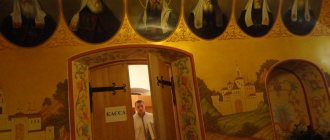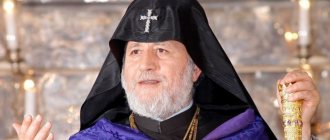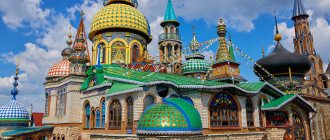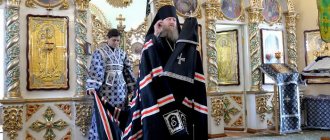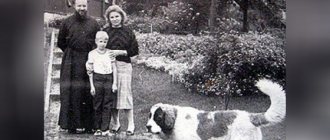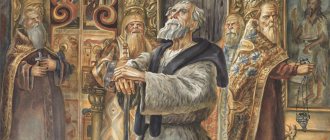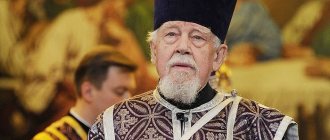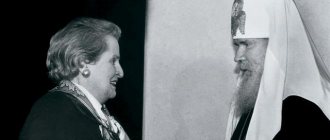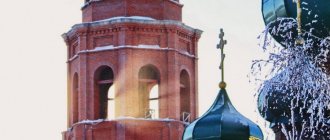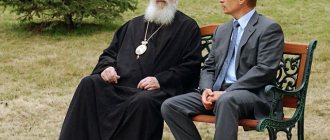History of the restoration of the patriarchate in Russia
A meeting of the Council of Bishops of the Russian Orthodox Church is taking place in Moscow. During the cathedral, the Relics of the first Patriarch Tikhon were transferred from the Donskoy Stavropegic Monastery to the Cathedral of Christ the Savior. MIR 24 correspondent Roman Parshintsev recalled the history of the patriarchate in Russia.
The meeting of the Council of Bishops is timed to coincide with the centenary of the restoration of the patriarchate in Russia, which happened on October 28, 1917. Then Patriarch Tikhon was elected head of the Russian Orthodox Church.
Prayer service to Saint Tikhon at his relics in the Cathedral of Christ the Savior. 100 years ago, it was he who became the first patriarch after the two-hundred-year abolition of the patriarchate by Peter the Great.
“When the last Patriarch Adrian died, church governance was established by the Holy Synod and the Patriarch was no longer elected for 200 years,” says Hegumen Gregory, Dean of the Donskoy Monastery.
After the revolution, finding themselves without a tsar, the Orthodox need a spiritual mentor. The Patriarch is elected at a local council in the year 17. And not by voting, but by drawing lots.
“The liturgy was performed, and all these lots were written in a special way on small letters in the presence of representatives of the cathedral. Hieroschemamonk Alexy Solovyov - so he drew this lot,” says Alexey Beglov, a senior researcher at the Institute of World History of the Russian Academy of Sciences.
In his first speech as patriarch, Tikhon seemed to predict that the country would face “crying, groaning and grief.” After the October coup, the entire church system, in fact, is outlawed. There is a real war going on against the clergy. Bishops are killed by the hundreds. Lenin called for the looting of churches under the pretext of fighting hunger. The newly elected patriarch for the country of Soviets becomes enemy number 1 after Nicholas II.
It is known that there were several attempts on Patriarch Tikhon’s life. One of them happened here, in his chambers. True, it was not Tikhon who opened the door to the attackers, but his cell attendant, Yakov Polozov. They shot him through the open door and killed him with five shots at point-blank range.
Patriarch Tikhon sharply criticizes the reprisals against the clergy. For this he is accused of counter-revolution and arrested. The saint is threatened with execution. The internal party struggle and tense relations in foreign policy at that time prevented the deal with the patriarch.
The Patriarch is released. But he did not live long in freedom. In March 25, on the feast of the Annunciation, Saint Tikhon died. Officially - from heart failure. But there are also versions about his poisoning. Tikhon was canonized in 1981.
The Soviet government allowed the election of the next Patriarch of Moscow and All Rus' after Tikhon only in 1943. He became Patriarch Sergius (in the world Ivan Stragorodsky).
“So they designed such a maneuver. Release Patriarch Tikhon, but leave him under investigation. Get concessions and statements from him,” adds Alexey Beglov.
TEMPLE OF THE HOLY DUCHESS OLGA IN OSTANKINO
The election of St. Tikhon to the Patriarchal throne, which occurred on November 18, 1917, marked the end of the Synodal period and the beginning of a new era in the history of the Russian Church. In our article today we will understand why the restoration of the patriarchate took place in 1917, and we will also see how Saint Tikhon himself, after his election, described the patriarchal service ahead of him.
The Synodal period is the 200-year period from 1721 to November 1917, when the highest authority of the Russian Orthodox Church was the Holy Synod , established by Peter I. This body included the most influential hierarchs of the Russian Church, and there was also a state observer - chief prosecutor .
Thanks to the Holy Synod, the Church was integrated into the state system , and thus the state could exert pressure on it. For example, the emperor could, if he wished, promote the people he needed to the Synod, slow down any reform related to church life, etc. On the other hand, the intervention of the emperor could be a good thing - for example, when the members of the Synod could not agree on the possibility of canonizing St. Seraphim of Sarov, Emperor Nicholas I took matters into his own hands, and the process of canonization began.
In other words, during the Synodal period both negative and positive processes took place, but on the whole the Holy Synod successfully resolved emerging church issues, and the absence of the Patriarch did not call into question the very existence of the Church in Russia, because the conciliar form of its governance was preserved.
Why then was it so important to restore the patriarchate in 1917?
In order to answer this question, we must first understand a little about the issue of governing the Church.
As we know, the Head of the Church is Christ. The basis of the Church is conciliarity , and therefore the dogmas of faith and the rules of church life have always been approved not by any one hierarch, but by the Council of Bishops, and this is how the Savior’s words about the unity of believers were realized:
May they all be one, just as You, Father, are in Me, and I in You, so may they also be one in Us, so that the world may believe that You sent Me (Jn. 17:21).
The conciliar unity of bishops forms the unity of the Church, in which the Holy Spirit reveals Himself.
But since the Council cannot be held very often, everyday issues are dealt with by the heirs of the apostles - the bishops . And since apostolic times there has been a rule: “It is fitting for bishops of every nation to know who is first among them, and recognize him as the head, and not do anything beyond their authority without his judgment.” The Patriarch became such a bishop - the first among equals . He is the face of the Church (but not its head in the literal sense of the word) and deals with issues related to the management of Local Churches, expresses the views of Christians to the outside world, builds relations between the state and the Church, and also monitors the regular convening of Councils, which approve its most important solutions.
Now let's return to the Local Council of 1917-1918.
At the opening of the Council in 1917, in fact, not very many of its participants spoke seriously about the restoration of the patriarchate. This idea became truly relevant in the fall of 1917 , when it became clear that the Provisional Government could not control the situation, the country was plunging into chaos, and power was concentrated in the hands of the extreme left and extremely aggressive groups, including in relation to the Church. Already at that time, the Church lost some of its powers (for example, the ability to teach the Law of God in schools), and it could not remain faceless, led only by the Synod, which had lost state support. As Bishop Mitrofan of Astrakhan said,
“In all the dangerous moments of Russian life, when the helm of the church began to tilt, the thought of the Patriarch was resurrected with special force. Time imperatively demands feat, boldness, and the people want to see at the head of the life of the Church a living personality who would gather living national forces .”
And so, in one of the most difficult periods of Russian history, when the Bolsheviks had just seized power, Saint Tikhon was elected to the patriarchal throne. He understood perfectly well that under the prevailing conditions this rank was tantamount to bearing the cross of confession:
Your message about my election as patriarch is for me that scroll on which it was written: Weeping, and groaning, and grief, and which scroll the prophet Ezekiel had to eat (Ezekiel 2:10; 3:1). How many tears and groans I will have to swallow in the patriarchal service ahead of me, and especially in these difficult times! Like the ancient leader of the Jewish people, the prophet Moses, I too will have to speak to the Lord: Why are You torturing Your servant? And why have I not found mercy in Thy sight, that Thou hast laid upon me the burden of all this people? Did I carry all this people in my womb and did I give birth to him, that You say to me: carry him in your arms, as a nanny carries a child... I alone cannot carry all this people, because they are heavy for me (Numbers 11: 11 – 14). From now on, I am entrusted with the care of all the Russian churches and will have to die for them all the days .
Saint Tikhon, Patriarch of Moscow and All Rus'
And indeed, the life of Patriarch Tikhon after this became a daily martyrdom, but in his person the Church found a spiritual leader, a symbol of unity, conciliarity and fidelity to Christ . A new period in the history of the Russian Church began.
You can read more about how the election of Saint Tikhon at the Council took place here.
Participants of the Council
The elective democratic principle was also in effect when forming the composition of the participants of the Local Council. Delegates were elected from each diocese - two representatives of the clergy and three laymen who had equal voting rights. Public institutions and government bodies - universities and the Academy of Sciences, the army, the State Duma, the military and scientific clergy - sent their representatives. The Synod and Pre-Conciliar Council, diocesan bishops, and abbots of the most important monasteries also took part in the Council. Two dozen advisory commissions were supposed to prepare decisions on key issues and then submit them to a general vote.
The working hours of the Council coincided with the key events of Russian history - the First World War, the proclamation of the Republic, the October Revolution, the beginning of the Civil War. The Council condemned the actions of the Bolsheviks, and the Council of People's Commissars, in turn, in January 1918 issued a Decree on the separation of church and state, but the new government has not yet interfered in the activities of the clergy.
ROC and revolution
Nicholas II did not give permission to hold the Council, although projects for church reforms were submitted to him starting in 1904. The emperor’s relationship with the Russian Orthodox Church was also influenced by personal circumstances - bishops and priests fell into disgrace for criticizing Nicholas II’s favorite G. E. Rasputin. In March 1917, the Russian Orthodox Church supported the abdication of the Tsar; moreover, many members of the clergy perceived this as the first step towards the revival of the Church and Russia.
In March-April 1917, a new composition of the Synod of Bishops was created, which included mainly supporters of reforms. Already on April 29, he issued a message announcing the imminent convening of the Local Council and the need for elections to occupy leading positions in the Russian Orthodox Church. Free elections of metropolitans took place in Petrograd and Moscow. It is significant that the population cast their votes for bishops who are morally impeccable and far from politics.
Circumstances of convening the Council
At the beginning of the 20th century, the Russian Orthodox Church was going through hard times - many representatives of the clergy dreamed of freeing the church from the restrictions of the synodal system of government created by Peter I. The head of the church was the emperor, and it itself represented, in fact, one of the government departments with certain bureaucratic, propaganda, even police functions.
Some priests and representatives of the Orthodox intelligentsia did not support the policies of the head of the church and state, sharing the views of the opposition or the labor movement. Thus, the most prominent figure in the events of Bloody Sunday 1905 was the priest G. Gapon, who stood at the head of a mass procession of unarmed workers. At the same time, part of the clergy belonged to the monarchists and collaborated with extreme right-wing forces, such as the Black Hundreds.
Internal church contradictions also required solutions. For example, it was necessary to clarify the role and rights of the laity - whether they should participate in the management of the parish or the concept of the parish is administrative and subordinate only to the higher clergy. The position of the white (married) and black clergy also raised questions. Bishops were elected exclusively from among the latter, although in the early Christian church married priests could also become bishops.
Chapter 2. Moscow Cathedral 1917–1918
The All-Russian Church Council opened in Moscow on the feast of the Dormition in 1917. The delegates of the Council were 564 people - 80 bishops, 129 priests, 10 deacons, 26 psalm-readers, 20 monastics (archimandrites, abbots and hieromonks) and 299 laity. Bishops removed from their cathedras, for example, Metropolitans Macarius (Nevsky) and Pitirim (Oknov), could not take part in the Council. Archbishop Anthony (Khrapovitsky), dismissed from the Kharkov see, became a member of the Council from the monastics, but by the beginning of its opening he was re-elected to the Kharkov see and took part in the meetings as a diocesan bishop. The Council included all those present in the Synod and the ruling bishops of the Russian Church, members of the Pre-Conciliar Council, governors of laurels and abbots of large monasteries, the head of the military clergy, Protopresbyter Georgy Shavelsky, and the rector of the Assumption Cathedral, Protopresbyter Nikolai Lyubimov.
The main part of the Council consisted of delegates from 66 dioceses - each elected a ruling bishop, two clergy and three laymen. In addition, delegates from monastics, from the military and naval clergy, from the active army, from fellow believers, from theological academies, from the Academy of Sciences and universities, from the State Duma and the State Council gathered in Moscow. Representatives of the Romanian and Serbian Churches took part in the Council. At the end of the Divine Liturgy, performed by Metropolitans Vladimir of Kyiv, Veniamin of Petrograd and Platon of Tiflis, a religious procession and prayer service took place on Red Square. The head of the Provisional Government, A.F. Kerensky, also took part in these solemn services.
The next meeting of the Council took place on August 16 in the Cathedral of Christ the Savior under the chairmanship of Metropolitan Vladimir (Epiphany). On this day, greetings were read to the Council. Working sessions began only on August 18 at the Moscow Diocesan House. Metropolitan Tikhon (Bellavin) of Moscow was elected chairman of the Council, and Metropolitan Vladimir (Epiphany) was elected honorary chairman.
The comrades (deputies) of the chairman were Archbishops Arseny (Stadnitsky) and Anthony (Khrapovitsky), Protopresbyters G. Shavelsky and N. Lyubimov, as well as representatives of the laity - Professor E.N. Trubetskoy and M.V. Rodzianko. Since the latter did not appear at the Council, his place in February 1918 was taken by the former chief prosecutor A.D. Samarin. V.P. Shein (later Archimandrite Sergius) became the Secretary of the Council, and Metropolitan Platon of Tiflis, Archpriest A. Rozhdestvensky and Professor P.P. Kudryavtsev became members of the Council Council.
The Council had to answer many questions that had accumulated over many years, for the convenient solution of which a number of working departments and commissions were formed. In total, 23 departments and 3 meetings were created under the Cathedral Council. The department of Higher Church Administration was headed by Bishop Mitrofan (Krasnopolsky), the department of diocesan administration - Bishop Georgy (Yaroshevsky), the church court - Archbishop Sergius (Stragorodsky), worship, preaching and churches - Archbishop Eulogius (Georgievsky), external and internal mission - Metropolitan Platon ( Rozhdestvensky), Edinoverie and Old Believers - Archbishop Anthony (Khrapovitsky).
The Council could not help but respond to the events taking place in the country. Seeing mass desertion and a breakdown in discipline in the army, the delegates appealed to the soldiers to continue fulfilling their duty. Another issue was related to the preparation of elections to the Constituent Assembly. The country was in the midst of an election campaign, and the statements of some candidates were clearly anti-church in nature. In this regard, the Council decided to address the people with a message, which stated that the criterion for election should not be the candidate’s affiliation with one party or another, but his devotion to the fatherland and the Church.
The Council attempted to prevent the seizure of parochial schools from the Church. However, these schools were associated by the new authorities with the “old regime,” and therefore the efforts of Orthodox zealots ended in failure.
The most famous act of the Council was the election of the patriarch. Initially, the issue of restoring the patriarchate was not on the agenda, but the growing tension in the country gradually changed the mood of the council - the need for a visible symbol of the unity of the Russian Church and a symbol of historical Orthodox Russia was felt by many.
On October 11, Bishop of Astrakhan Mitrofan (Krasnopolsky) made a proposal to restore the patriarchate. According to the saint, the patriarchate has always existed in the Russian Church - in the first centuries after baptism it was subordinate to the Ecumenical Patriarch, and in 1589 it received its own patriarch. Bishop Mitrofan called the abolition of the patriarchate under Tsar Peter I a violation of the canons - primarily the 34th Apostolic Canon and the 9th Canon of the Antioch Council.
Hieromartyr Mitrofan was not alone - the idea of restoring the canonical administration of the Church was supported by a large part of the Council. In addition to canonical principles, historical and ideological principles were cited. The most striking was the speech of Archimandrite (later Archbishop) Hilarion (Troitsky):
“Moscow is called the heart of Russia. But where does the Russian heart beat in Moscow? On the exchange? In shopping arcades? On Kuznetsky Most? It is fought, of course, in the Kremlin. But where in the Kremlin? In the District Court? Or in the soldiers' barracks? No, in the Assumption Cathedral. There, at the front right pillar, the Russian Orthodox heart should beat. The eagle of Peter the Great, in the Western manner of a structured autocracy, pecked out this Russian Orthodox heart, the sacrilegious hand of the wicked Peter brought the Russian High Hierarch from his centuries-old place in the Assumption Cathedral. The Local Council of the Russian Church with the power given to it by God will again place the Moscow Patriarch in his rightful, inalienable place.”
Objections to the restoration of the patriarchate boiled down to the fact that the election of a patriarch would interfere with conciliarity and lead to despotism. For example, Archpriest Nikolai Dobronravov (future archbishop and holy martyr) saw echoes of Catholicism in unity of command and said that history knows of cases of unworthy behavior of the heads of Local Churches. However, the voices of opponents of the patriarchate, persistent at first, met with less and less support with each meeting and gradually drowned among the general upsurge and inspiration. Moreover, the election of the high priest did not mean the dictatorship of one person and the abolition of conciliarity - the highest church authority was to remain with the Councils.
On October 28, the Council decided:
“In the Orthodox Russian Church, the highest power - legislative, administrative, judicial and supervisory - belongs to the Local Council, convened periodically at certain times, consisting of bishops, clergy and laity.
The patriarchate is restored, and church administration is headed by the patriarch.
The Patriarch is the first among his equal bishops. The Patriarch, together with the church governing bodies, is accountable to the Council.”
The election procedure was also determined. Members of the Council were required to submit notes with the name of the candidate. If one received more than half the votes, then the elections were considered valid. If none of the candidates received the required number, a second vote was held. Now notes with the names of three candidates had to be submitted. The one who received the majority of votes was considered elected candidate. After three people scored the required number of points, they were supposed to choose one of them by lot.
Many believed that Archbishop Anthony (Khrapovitsky) would become patriarch. An outspoken publicist, he was popular among the people since pre-revolutionary times for his consistent Orthodox position. On the pages of the press, the hierarch spoke out on many issues of state and church life, for example, regarding reforms, common faith, and relations with heterodoxy. The archpastor was also known as a monarchist, as a supporter of the return of Constantinople to the Orthodox kings. Long before the Council, the Archbishop popularized the restoration of the patriarchate and contributed to the invitation of Patriarch Gregory IV of Antioch to Russia in 1913. However, Archbishop Anthony also had ill-wishers. Some opponents of the patriarchate admitted that they did not want its restoration for fear that a conservative and monarchist would become the patriarch. However, the alarm of this part of the Council was in vain - Archbishop Anthony was not destined to lead the Russian Church.
The first vote was scheduled for October 30. Archbishop Anthony received the largest number of votes (101). The remaining votes were distributed as follows. Archbishop Kirill (Smirnov) received 27 votes, Metropolitan Tikhon (Bellavin) - 23, Metropolitan Platon (Rozhdestvensky) - 22, Archbishop Arseny (Stadnitsky) - 14, Metropolitan Vladimir (Bogoyavlensky), Archbishop Anastasy (Gribanovsky), Protopresbyter Georgy Shavelsky - by 13, Archbishop Sergius (Stragorodsky) - 5, Archbishop Jacob (Pyatnitsky), Archimandrite Hilarion (Troitsky), A.D. Samarin - 3 votes each. Some candidates for the patriarchate were proposed by one or two members of the Council.
After four rounds of voting, three candidates were elected - Archbishop Anthony (Khrapovitsky) of Kharkov, Archbishop Arseny (Stadnitsky) of Novgorod, and Metropolitan Tikhon (Bellavin) of Moscow. They said that the Council elected as candidates the smartest, the strictest and the kindest of the Russian bishops.
On November 5 (18), 1917, the election of a patriarch took place in the Cathedral of Christ the Savior. The candidates for the patriarchal throne were not present in the church - they were all at the liturgy in other churches in Moscow. And in the Cathedral of Christ the Savior they were preparing for a great event. After the liturgy and prayer service, Metropolitan Vladimir (Epiphany) brought the reliquary with the lots to the pulpit and removed the seals from it. Elder Alexy (Soloviev) of the Zosimova Hermitage came out of the altar. The monk took out one of the lots and handed it to the metropolitan, who loudly proclaimed the name of the elected patriarch: “Tikhon, Metropolitan of Moscow - axios!”
Protodeacon Konstantin Rozov proclaimed many years to the elected Patriarch of Moscow and All Russia: “To our Most Reverend Metropolitan Tikhon of Moscow Kolomna, elected and named Patriarch of the God-saved city of Moscow and All Russia.”
Saint Tikhon celebrated the liturgy at the Trinity Metochion. The delegation of the Council, headed by Metropolitans Vladimir, Benjamin and Plato, informed him of his election.
On November 21, on the feast of the Entry into the Temple of the Blessed Virgin Mary, the enthronement of the new patriarch took place in the Assumption Cathedral of the Moscow Kremlin. For the solemn ceremony, relics of the great Russian hierarchs were taken - the staff of St. Peter of Moscow, the cassock of the holy martyr Patriarch Hermogenes, the mantle, miter and hood of Patriarch Nikon.
The restoration of the patriarchate in the Russian Church increased the status of a number of bishops. Thus, Archbishops Anthony (Khrapovitsky), Arseny (Stadnitsky), Agafangel (Preobrazhensky), Sergius (Stragorodsky), Jacob (Pyatnitsky) were elevated to the rank of metropolitans.
The election of Saint Tikhon as patriarch was providential. Even opponents of the patriarchate said that they had come to terms with this idea thanks to the personality of the high priest.
The election of the patriarch also implied the definition of the range of his rights and responsibilities: to take care of the well-being of the Russian Church and represent it before the state authorities, to communicate with the Autocephalous Churches, to address the flock with messages, to take care of filling the bishop's departments. The Patriarch was the ruling bishop of the patriarchal region, which included the Moscow diocese and stauropegic monasteries.
Directly subordinate to His Holiness were the Kremlin cathedrals, temples and monasteries, the Trinity-Sergius Lavra, stauropegic monasteries and patriarchal institutions. The rest of the Moscow diocese was to be governed by the patriarchal vicar.
The highest authority in the Russian Church was the Local Councils, in between which the Holy Synod and the Supreme Church Council (SEC) operated. The first was in charge of matters of a pastoral, doctrinal, liturgical nature, the second was in charge of administrative, economic and school-educational matters. Key issues - the protection of the rights of the Church, preparation for the Councils, the opening of dioceses - were subject to joint consideration by both the Holy Synod and the Supreme Church Council, the Synod, in addition to the patriarch, included 12 members - the Kiev Metropolitan, six hierarchs by election of the Council for three years, five hierarchs called alternately for one year. The All-Russian Central Council included 15 people - the patriarch, three bishops delegated from the Synod, one monk, five representatives of the white clergy, six laymen elected by the Council.
A “Definition on the legal status of the Church in the state” was developed. According to the document, the Orthodox Russian Church
occupies a leading public legal position among other confessions;
independent from the state in the teaching of faith and morals, worship, internal church discipline, relations with other Local Churches;
resolutions of the Russian Church and acts of church administration are recognized by the state as having legal significance;
state laws concerning the Church are issued by agreement with the church authorities;
the head of the Russian state, the minister of confessions, the minister of public education and their companions and (deputies) must be Orthodox;
the property of the Orthodox Church is not subject to confiscation.
However, all these decisions could not be valid - by that time (October 25, 1917) power had been seized by the Bolsheviks. The riots moved to Moscow, there was shooting in the streets,
The Kremlin, where the cadets were holed up, was fired upon by the Bolsheviks from cannons. The petitions of the Russian hierarchs to stop the destruction of the shrine did not lead to anything. The delegation did not immediately manage to penetrate the Kremlin.
The Council issued a call for general repentance. “Instead of the new social structure promised by the false teachers,” the message said, “there is a bloody strife among the builders; instead of peace and brotherhood of peoples, there is a confusion of languages and bitterness, the hatred of brothers. <…> ... To our misfortune, a truly national power worthy of receiving the blessing of the Orthodox Church has not yet been born. <…> Leave the crazy and wicked dream of false teachers who call for the implementation of world brotherhood through world civil strife! Return to the path of Christ."
